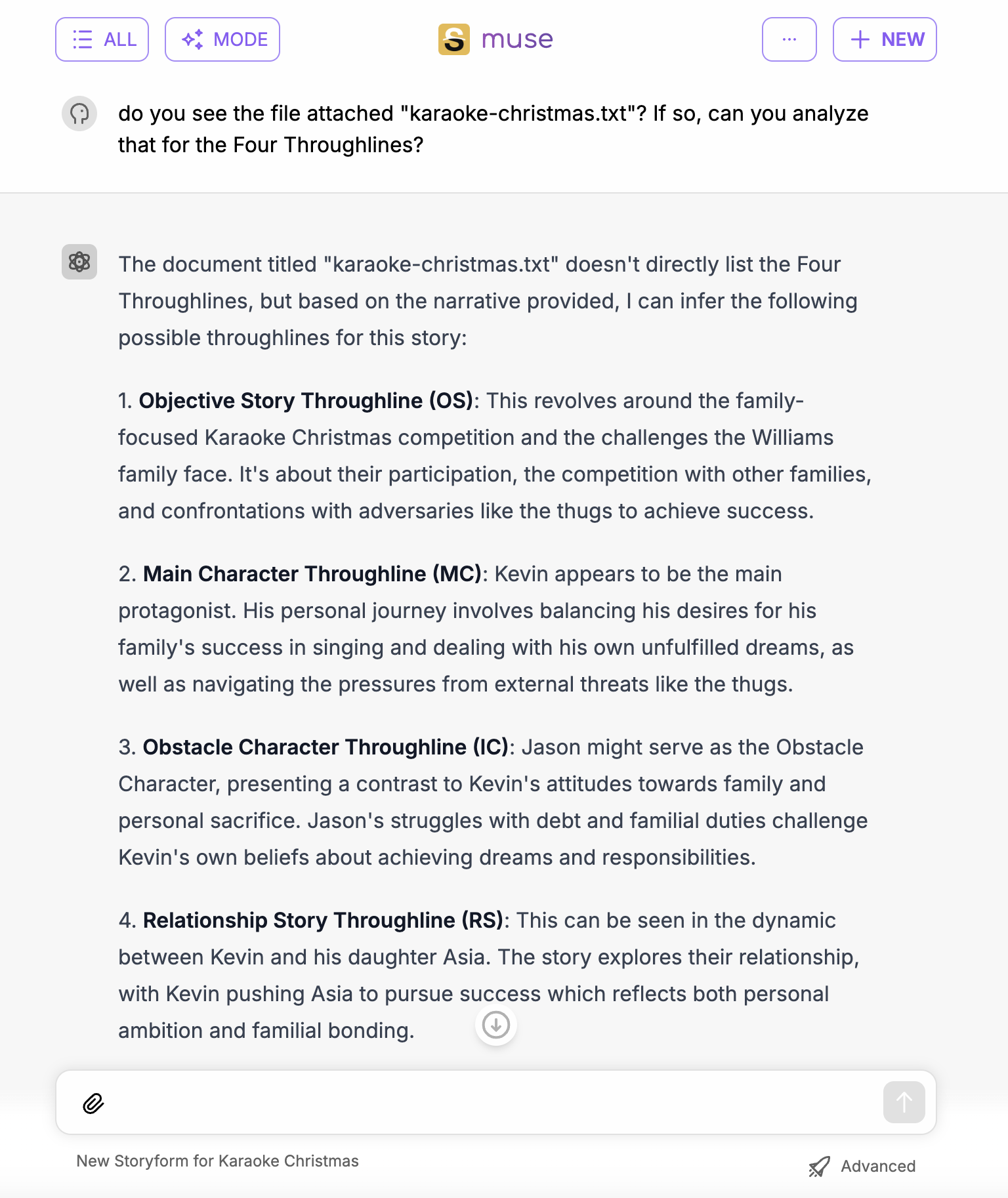Subtxt with Muse: The First-Ever Completely Accurate Storyform with Zero Human Input!
Storyform unlocked: Muse nails it without help
This is the moment we’ve been waiting for—and honestly, one we didn’t even think was possible when we first set out to build Subtxt nearly seven years ago. It’s official: for the first time ever, Muse has nailed the complete Storyform of a text all on its own. No human guidance. No intervention. Just pure narrative genius.
It all started when we decided to test out Muse’s ability to upload a document. We grabbed an 8-page treatment of an old spec project of ours called Karaoke Christmas—a light-hearted family holiday special.

We weren’t even planning to dive deep into analysis; we just wanted to see if the upload feature worked smoothly. But what happened next left us absolutely floored.

Let’s break down the steps Muse took, and how it surpassed all our expectations at every turn.
1. Identifying the Four Throughlines
After convincing Muse to stop teaching us about the Four Throughlines and instead focus on the uploaded file (we get it, Muse, you know your stuff!), we ran our first pass. And bam—Muse got them all 100% correct. It identified the Objective Story, Main Character, Influence Character, and Relationship Throughlines exactly as intended. We figured this might just be a fluke, so naturally, we kept testing.

2. Is the Main Character Changed or Steadfast?
Next up: determining whether the Main Character was a Changed or Steadfast character. For those unfamiliar, this decision is key—it defines whether the Main Character transforms by the end of the story (Changed) or holds onto their original perspective (Steadfast). Muse didn’t miss a beat—it accurately identified that our Main Character was Changed, recognizing how Kevin abandons his old ways and embraces a new approach by the story’s conclusion. This insight was spot-on, and it had us nodding in agreement as we saw our story’s core transformation come into sharper focus.

3. The Hardest Task: Identifying Sources of Conflict
Here’s where we really expected Muse to falter. One of the most challenging tasks for any AI (even our beloved Muse) is to accurately pinpoint the sources of conflict in each Throughline while keeping them in balance with the thematic elements. Yet, somehow, Muse managed to nail it. It carefully considered the relationships between Universe, Physics, Psychology, and Mind, ensuring that the Main Character and Obstacle Character Throughlines were perfectly opposed. It was like watching a master storyteller at work.

4. Determining the Story Goal: Physics Throughline
Now, we moved onto what’s historically been a tricky area for Muse—the Story Goal. For stories with an Objective Story Throughline in Physics, the possible Story Goals are Understanding, Doing, Obtaining, and Learning. Not only did Muse identify that the central goal in Karaoke Christmas was Obtaining, but it also correctly pegged the focus of the plot. A holiday family special with a plot revolving around “Obtaining”? Yeah, Muse got it spot on.

5. Final Touches: Story Driver, Mental Sex, and More
With the core elements in place, we asked Muse if it had everything it needed for a complete Storyform. There were still a few key pieces to determine: Story Driver, Mental Sex, Continuum, Outcome, and Judgment.

We already knew the answers (Success/Good was a pretty safe bet for this family-friendly story), but Muse came through once again, getting every single one right. It’s like Muse had been hiding its true potential until now.

6. Pivotal Elements: Where the Real Argument Happens
Next, we challenged Muse to identify the Pivotal Elements that represent the core argument between the Main Character and the Obstacle Character.

In the past, this is where Muse would struggle, offering conflicting options or even suggesting elements that didn’t exist in the model. But this time? This time, Muse identified all eight possible sets of Pivotal Elements and provided context for how each could play out based on our treatment. It was nothing short of phenomenal.

7. Picking the Perfect Set
Now came the fun part. We had a good idea which set of Pivotal Elements would fit best, but we wanted to see if Muse would pick the same top two choices. And guess what? It did! Muse zeroed in on the exact same elements we would’ve chosen—Conscience vs. Temptation. We were officially in awe.

8. Bringing It All Together
Finally, we asked Muse to create a Story and Storyform in Subtxt to track everything.

Within seconds, we had a thematically consistent Storyform, complete with 65+ Storypoints and Storybeats ready for further exploration. If this were a story we wanted to develop, we’d be able to dive in and explore every angle, ensuring a rock-solid narrative with no storyholes.

And just for fun, we asked Muse to generate an image of the big climactic moment—a father-daughter karaoke showdown where they, of course, win the competition. (After all, it’s a Success/Good story—how could they not?)

Wrapping Up
We can’t express enough how exciting this achievement is. After 30 years of narrative study, a decade of running our own story development agency, and now seven years of building Subtxt and Muse, we’ve reached a point where you can upload a treatment—without knowing a thing about narrative theory—and get a precise, thematically consistent Storyform in return. It’s the culmination of everything we’ve been working toward, and we can’t wait to see what’s next.
Thank you for your continued support, and stay tuned as we keep refining and expanding what’s possible with Subtxt and Muse. The future of storytelling is here, and it’s more exciting than ever. 🎤🎄
Happy writing!
Download the FREE e-book Never Trust a Hero
Don't miss out on the latest in narrative theory and storytelling with artificial intelligence. Subscribe to the Narrative First newsletter below and receive a link to download the 20-page e-book, Never Trust a Hero.

